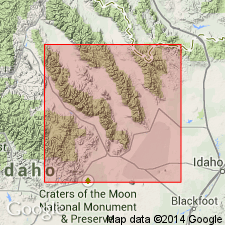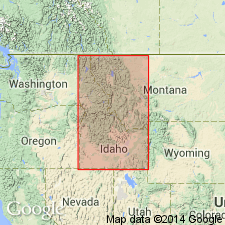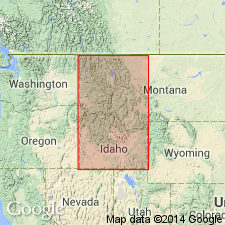
- Usage in publication:
-
- Bloom Member*
- Modifications:
-
- Named
- Dominant lithology:
-
- Limestone
- Sandstone
- Siltstone
- AAPG geologic province:
-
- Snake River basin
Summary:
Pg. 21, 24-28, figs. 1-4, 6. Bloom Member, basal member of Snaky Canyon Formation (new). Present in southern Lost River Range-Arco Hills, southern Lemhi Range, and southern Beaverhead Mountains, south-central Idaho. Consists of medium-gray to medium-dark-gray, thin- to medium-bedded limestone which weathers light-gray to medium dark-gray, interbedded with thin beds of medium-gray, very fine-grained quartzose sandstone or siltstone which weather pale yellowish-brown and light olive-gray. Limestone ranges in texture from aphanitic to coarse-grained, is sandy or silty through much of the interval, and contains numerous gray chert and brown-weathering incipient chert nodules. Brown-weathering, generally concentrically laminated, stromatolitic mounds are common. Thickness about 2,125 feet (647 m) at type. Gradationally underlies Gallagher Peak Sandstone Member of Snaky Canyon Formation; gradationally overlies Bluebird Mountain Formation (all new). Age is Late Mississippian to Late Pennsylvanian (late Chesterian to early Missourian). In addition to stromatolites, fossils include fusulinids and other Foraminifera, algae, brachiopods, corals, bryozoans, ostracodes, trilobites, mollusks, crinoid columnals, abundant encrinitic debris, and a few conularids. Foraminifers indicate that the Mississippian-Pennsylvanian boundary is above the gradational top of the Bluebird Mountain Formation as defined in this paper. Authors propose an arbitrary northern limit for the Arco Hills, Bluebird Mountain, and Snaky Canyon Formations at about Lat. 44 deg. 30 min. N.; volcanic rocks along northeast margin of Snake River Plain provide natural southern limit. Report includes correlation chart, measured sections, fossil list, geologic sketch map.
Type section (=type section of Bluebird Mountain Formation): about 3.5 mi (5.8 km) south of Bluebird Mountain on west flank of Gallagher Peak and on east side of saddle between Copper Mountain and Gallagher Peak, in secs. 29 and 30 (unsurveyed), T. 10 N., R. 31 E., [in vicinity of Lat. 44 deg. 10 min. 17 sec. N., Lat. 112 deg. 48 min. 19 sec. W.], Copper Mountain 7.5-min quadrangle, [Targhee National Forest], Clark Co., ID. Named from Bloom triangulation station, about 1.7 mi (2.7 km) south of Gallagher Peak, in sec. 32 (unsurveyed), T. 10 N., R. 31 E., [in vicinity of Lat. 44 deg. 08 min. 41 sec. N., Long. 112 deg. 47 min. 33 sec. W.] [Lat./Long. coords. from USGS GNIS database and ACME Mapper 2.0, accessed on Darwin's 200th birthday, 2009).]
Source: Publication; US geologic names lexicon (USGS Bull. 1564, p. 15); Changes in stratigraphic nomenclature, 1979 (USGS Bull. 1502-A, p. A8).

- Usage in publication:
-
- Bloom Member*
- Modifications:
-
- Biostratigraphic dating
- Age modified
- AAPG geologic province:
-
- Idaho Mountains province
Summary:
Age of the base of the Bloom Member is Late Mississippian in the White Knob Mountains and Early Pennsylvanian in the Beaverhead Mountains based on fossils [foraminifers, conodonts]. Top of the underlying Bluebird Mountain Formation is still Late Mississippian.
Source: GNU records (USGS DDS-6; Menlo GNULEX).

- Usage in publication:
-
- Bloom Member*
- Modifications:
-
- Biostratigraphic dating
- AAPG geologic province:
-
- Idaho Mountains province
Summary:
The Mississippian-Pennsylvanian, or Chesterian-Morrowan boundary lies in the basal beds of the Bloom Member, the basal member of the Snaky Canyon Formation in the Wood Canyon and Timbered Dome sections, White Knob Mountains, Custer Co, ID in the Idaho Mountains province. Northeastward from these sections to Gallagher Peak in the Beaverhead Mountains, ID the system boundary rises and the Bloom is only Morrowan in age. The Bloom is part of a continuous sedimentary sequence and part of an extensive carbonate bank deposit that developed in east-central ID from Early Mississippian lasting until Permian time. Placement of the system boundary is documented by collections of foraminifers and associated conodont faunas, and brachiopod fossils. Authors use RHACHISTOGNATHUS PRIMUS DUNN (conodont) as an indicator of the Mississippian-Pennsylvanian boundary; this conodont was found 8.5 m above the base of the Bloom at Wood Canyon and 1.5 m above the base of the Bloom at Timbered Dome. Fossils listed. Columnar sections.
Source: GNU records (USGS DDS-6; Denver GNULEX).
For more information, please contact Nancy Stamm, Geologic Names Committee Secretary.
Asterisk (*) indicates published by U.S. Geological Survey authors.
"No current usage" (†) implies that a name has been abandoned or has fallen into disuse. Former usage and, if known, replacement name given in parentheses ( ).
Slash (/) indicates name conflicts with nomenclatural guidelines (CSN, 1933; ACSN, 1961, 1970; NACSN, 1983, 2005, 2021). May be explained within brackets ([ ]).

